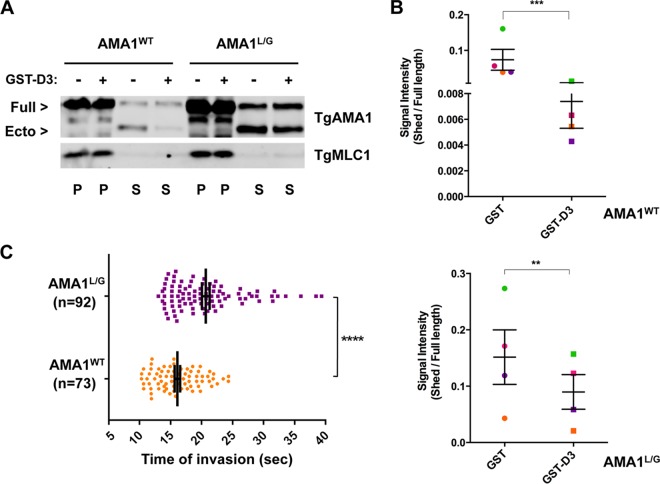FIG 4 .
Parasites expressing a hypercleavable form of TgAMA1 (AMA1L/G) take longer to invade than parasites expressing AMA1WT. (A) A microneme secretion assay was performed using conditional AMA1WT and AMA1L/G parasites treated with either 1 µM GST-D3 (+) or GST (−). GST-D3 treatment caused decreased shedding of TgAMA1 in both parasite lines, but there was considerable cleavage and shedding of the mutant protein even after GST-D3 treatment. TgMLC1 was used as a loading control. Full-length TgAMA1 detected in the supernatants (S) is likely due to parasite lysis. P, pellet. (B) Signal intensity ratios of ectodomain in the supernatant to full-length protein in the pellet from four independent microneme secretion assays using AMA1WT and AMA1L/G parasites treated with either 1 µM GST or GST-D3. Paired signal intensity values from each of the biological replicates were plotted using the same color symbols. Values are means ± SEM (error bars). A paired one-tailed t test revealed a significant decrease in the amount of TgAMA1 shed from both AMA1WT parasites (***, P = 0.0001) and AMA1L/G parasites (**, P = 0.0039) following treatment with GST-D3. (C) Quantification of the duration (in seconds) of host cell penetration by AMA1L/G (n = 92) and AMA1WT (n = 73) parasites. Mean penetration times, indicated by tall vertical lines, were 20.7 and 16.1 s, respectively. Shorter vertical lines indicate SEM. A two-tailed unpaired t test with Welch’s correlation revealed a significant difference between the two data sets (****, P < 0.0001).

